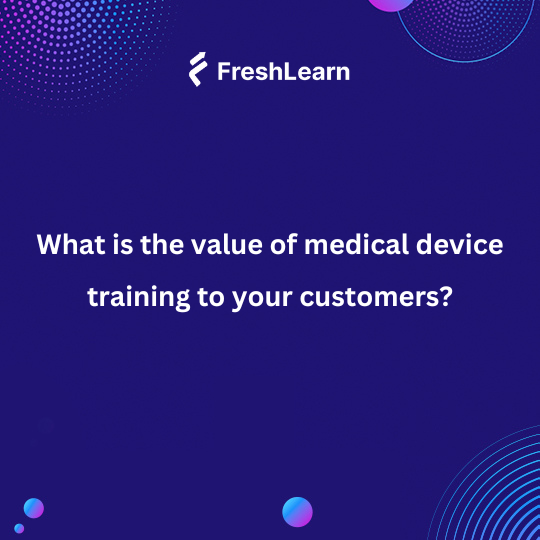
What is the value of medical device training to your customers?
When considering the advantages of medical device training, most medical facilities consider how it would help employees. And while compliance with the regulations is for sure valuable in a job done well, proper training is also worthwhile for customers.
How, you ask? It boils down to good customer service. Medical devices are growing increasingly more complex. Understanding what they do requires proper training to maintain service expectations for your existing audience and convert new customers.
This guide will delve into everything you need to know to plan a medical device training curriculum, including the components of such a program and the right training delivery methods.
The Importance of Medical Device Training
With customer satisfaction at the forefront of your commitment to medical device training, learn about the benefits your medical facility can expect.
1. Compliance with Regulations
FDA guidelines and regulatory requirements like ISO 13485 set the framework for proper medical device usage. Training in areas like choosing quality suppliers, process validation, and design control ensures your medical facility complies with the ongoing regulations.
In turn, your customers will feel confident in choosing your medical services versus those of one of your competitors.
2. Competence and Error Reduction
Practice makes perfect, which is why medical device training is a key part of improving employee performance. The more familiar an employee becomes with specific medical devices, the more competent they are.
Ultimately, the customer or patient benefits most here. They can schedule checkups, appointments, and medical services with your facility without worries about their safety.
The lack of user errors also assists your employees in making correct diagnoses and prescribing treatments, further bolstering customer trust.
Key Benefits of Medical Device Training
There are yet more strong, compelling reasons to prioritize medical device training for your business. Take a look below.
1. Improved Employee Performance and Morale
When you hired your medical staff, you did so with a mutual commitment to excellence. Your employees want to perform at their best, and you want that for them. However, outdated medical device knowledge doesn’t help them or your customers.
Training them in the latest medical device usage and regulations is a great way to elevate their performance. Your team will operate with confidence, and you can hone in on your employees’ strengths.
Better yet, your team will feel valued. If you’ve suffered from a high turnover rate at your medical facility, the number of people leaving their roles should lessen if they receive proper training.
2. Addressing Staff Weaknesses
Although no one likes to admit they have weaknesses, we all do. After all, no one’s perfect. It behooves your medical facility to find the weaknesses within your staff. You can use training to mend knowledge gaps and other problems that have arisen.
Proper training will keep your employees more efficient and reduce their risk of accidents.
3. Enhancing Consistency and Uniformity
All employees operating under the same title should have a fair working shot no matter their tenure. Medical device training puts everyone on even footing with baseline knowledge for the entire staff.
This is to everyone’s benefit. When your team performs, they’ll have uniformity in their procedure compliance and medical device usage.
Components of an Effective Medical Device Training Program
If your medical facility is building a training curriculum from scratch, make sure it has the following components.
1. Ongoing and Varied Training Methods
Since new medical devices never stop coming down the pike, you have to plan for long-term training. Keeping the material fresh requires you to change up the training methods you use.
For example, you might train some team members on concepts or regulations in peer-to-peer sessions or hold larger-form classroom instruction.
Besides the type of training, its duration is also important. The average attention span isn’t much longer than 20 minutes. You have to keep that in mind as you prepare your materials.
The longer your course goes on, the more glazed eyes you’ll see around the classroom. Keep your training sessions short yet focused. This will allow everyone to stay sharp and retain more of the information they learned.
2. Competency Assessments
Although this isn’t grade school anymore, testing your employees on what they learned is still a valuable tool. You can use an assessment to gauge how much information they’re really understanding.
You might issue these assessments monthly or bimonthly, or perhaps you wait until a substantial medical device update or change comes through. A competency assessment ensures your team is equipped to apply their skills practically in a day-to-day environment.
If your team falls short in some areas, consider one-on-one or small-group training to get them up to speed.
3. Comprehensive Coverage
Medical device training must go in-depth on all areas of how a device works, including how to turn it on and off, what it does, when it’s used, features, and troubleshooting. Rather than cram all this information into one lesson, break down each purpose of the medical device into separate, smaller lessons.
Methods of Delivering Training
There are so many ways to provide medical device training that you can always afford to keep it interesting. The types of instruction you offer will vary based on your budget, the location of your staff, and the available space for training.
Let’s take a look at your options.
1. In-Person and Peer Learning
An in-person training environment is how many of us remember growing up learning in school. Your employees would gather in a classroom or breakroom and sit down for ongoing instruction on medical device usage.
Within that same vein is peer learning, where fellow staff members help one another fill in the gaps in their knowledge. Learning from peers can help your team better learn the virtues of teamwork, sociability, patience, and cooperation.
As a whole, in-person training is beneficial for facilitating a face-to-face environment. You can answer questions in real-time. You can also read your employees’ faces to see if your lessons are resonating or going on for too long.
2. eLearning and Virtual Instructor-Led Training (VILT)
Online instruction or eLearning is becoming an increasingly popular learning method. Virtual instructor-led training, also known as vILT, goes hand in hand with eLearning, as it simulates or relies on virtual teaching environments.
One of the biggest benefits of eLearning is that it can occur anywhere. Instructors don’t need to worry about acquiring physical learning space. Students don’t have to travel and can learn in an environment they feel most comfortable in.
However, you must be ready to combine learning modalities to account for the varying needs of your staff when using eLearning. That will keep people paying attention, as distractions are more common when learning virtually.
3. Microlearning and Gamification
Gamification involves making learning fun by adding a competitive element. Your team will want to remember more of the information you teach them if they feel like they “win” for doing so. Even if one student outperforms the other, in the end, gamification ensures everyone wins.
After all, your staff is learning the material, which is all you can ask for as a medical device instructor. Microlearning is another way to drive up retention. As discussed, the average person doesn’t have a high attention span. Using microlearning, in which you shrink lessons and make complex topics more understandable, spurs better understanding among all your staff.
Real-World Impact of Medical Device Training
Plenty of studies and examples out there bolster the value of medical device training. Below, take a look at one such case study and a review of which financial incentives exist in proper medical device usage.
1. Case Study
A radio-surgical equipment producer based in the United States had a Class IIb device for which they sought CE Mark approval. This would allow them to introduce the medical device into Europe.
However, the manufacturer ran into several difficulties. For one, they didn’t have enough clinical data on the medical device due to its recent commercialization date. Additionally, there existed technical documentation gaps.
The manufacturer worked with Celegence, which produces regulatory publishing and compliance for medical devices and pharmaceuticals. Celegence’s team insisted on a CER Remediation Project and Gap Analysis.
The analysis determined more than 280 clauses. Due to that report, Celegence recommended best practice templates for medical device learning. Employees received in-class instruction on European medical device compliance and regulation and were able to branch out of their market.
2. Value-Based Purchasing and Reimbursement
The connection between training and improving your healthcare quality can’t be glossed over. Your medical facility can reap many financial incentives through safe patient outcomes and proper device usage.
For instance, you can avoid costly malpractice lawsuits that can wreck your hard-earned business reputation.
Conclusion
Medical device training is a necessity in improving staff confidence. Those benefits trickle down to your customers, who receive prompt, safe, and accurate care from the medical professionals they need it most from.
There are many ways to initiate medical device training. What matters more than how you do it is that you do it consistently.



